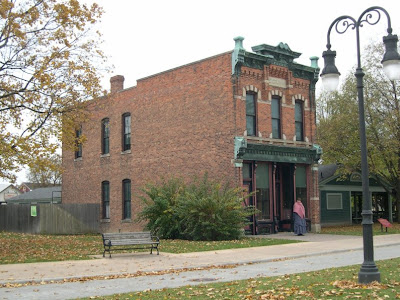Ford Home (formerly known as Henry Ford Birthplace)

The last historic building Henry Ford had personally moved to Greenfield Village before his death was the first one he preserved: his family homestead. It was in this house, on July 30, 1863, in which Henry Ford, the first of William and Mary's six children, was born.
As a youth, he spent many hours at a workbench set up in a bedroom where he devised a set of handmade tools and became, by the age of 15, the community watch repairman. He showed more of an interest in machinery than agriculture and left the farm at age 16 to pursue his fortunes as a machinist in Detroit.
 In 1919, highway officials decided to extend Greenfield Road south through the Ford farm. Unfortunately, the homestead was directly in the proposed road's path. The family's decision to move the house and the outbuildings prompted Ford's first restoration project.
In 1919, highway officials decided to extend Greenfield Road south through the Ford farm. Unfortunately, the homestead was directly in the proposed road's path. The family's decision to move the house and the outbuildings prompted Ford's first restoration project.So, that same year, Mr. Ford began the preservation of his birthplace, a simple two-story clapboard farmhouse built in 1861 on the dividing line of Springwells and Dearborn Townships in Michigan by his father William. He obtained every piece of original furniture, pictures, and equipment that could be found.
 Those that were unavailable he replaced with similar objects of the same period, such as the Victorian sofa and chairs in the parlor.
Those that were unavailable he replaced with similar objects of the same period, such as the Victorian sofa and chairs in the parlor. His goal was to have the house look exactly as he remembered it from the time period of his mother's death, 1876, when he was just 13, and spared nothing in doing so. A fine example of his meticulous restoration was the search for the dining room stove the home originally had; he sent his men out scouring the countryside for 18 months until the exact stove he needed was found.
His goal was to have the house look exactly as he remembered it from the time period of his mother's death, 1876, when he was just 13, and spared nothing in doing so. A fine example of his meticulous restoration was the search for the dining room stove the home originally had; he sent his men out scouring the countryside for 18 months until the exact stove he needed was found.Every antique shop between Detroit and Cincinnati was combed, looking for the exact shade of red carpeting for the stairs, while workers began digging at the homestead's original site - thought to be the first archeological dig in the restoration of a historic house - to help with the research. Everything that was found, nails, pieces of dishes, and anything else, was brought to Ford, and he would show them to his brothers and sisters to ensure accuracy. In this way, Ford was able to reproduce exact replicas from the original artifacts.
I have not read why Ford hadn't moved the home to Greenfield Village before 1944, but, evidently, the restored farmhouse's chances of survival in a developing area and the need for 24 hour security protection from vandals worried him. Because of the proximity of the dwelling to the Village did not require one of architect Ed Cutler's disassemblies, it was simply cut in two and hauled over by truck, with some of the outbuildings already in place. Unfortunately, however, available space did not permit the transferring of all of the barns and sheds. But, once reassembled inside the Village, the completed homestead, with the white picket fence and outbuildings were arranged in their original positions.
The completion of this project gave Ford quite a present the day before his 81st birthday - July 29, 1944.
The following three pictures are of the Ford kitchen
where the sights and smells of a time long gone
still live on.
where the sights and smells of a time long gone
still live on.


 The home now has presenters in period clothing, cooking on the wood stove in the kitchen, working on a punch needle rug with the push-punch process using wool and burlap, or as information givers.
The home now has presenters in period clothing, cooking on the wood stove in the kitchen, working on a punch needle rug with the push-punch process using wool and burlap, or as information givers. The home is a seasonal home, meaning that you will see tasks of the season being presented here, such as sheep shearing in the springtime, and a period correct Christmas tree during the Christmas season.
The home is a seasonal home, meaning that you will see tasks of the season being presented here, such as sheep shearing in the springtime, and a period correct Christmas tree during the Christmas season.It is a particular favorite of mine and I enjoy the visits each time I'm there. Another excellent example of living history presented wonderfully!
.






Comments